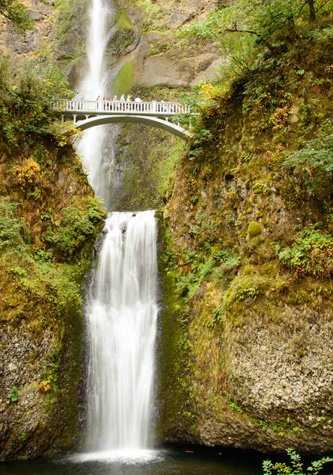We spent a busy day in the Columbia River Gorge. The Gorge is a remarkable area of transition through space and time. Here, east meets west biologically, culturally, and historically.
We woke just below Bonneville Dam. As light grew, we saw walls of basalt stair-stepping hundreds of feet above us, and spectacular waterfalls tumbling down their sides. The basalt was laid down in a series of searingly hot lava flows that inundated much of Washington and Oregon. Later, unimaginably huge floods of water ripped through the Gorge, carving the stone into its present near-vertical state. Bonneville Dam was the first major dam on the Columbia, and as we approached we considered Roosevelt and Depression-era electrification, and the aluminum production that helped win WWII. As Bonneville lock lifted us sixty feet, we sang Woodie Guthrie’s “Roll On, Columbia,” and considered the political conditions of the time, and the ironies of the song that have become apparent decades later.
Just after passing the dam, we docked at Cascade Locks. Boarding buses, we back-tracked to Multnomah Falls. No wonder this is the most-visited spot in Oregon. Two watery ribbons totaling 620 feet are joined by a bridge built to enhance the natural scene. Some of the intrepid zigzagged to the top of the falls; others, more prudent, enjoyed the view from more reasonable perspectives.
Back on the ship, we made our way to Hood River. Our afternoon was devoted to sampling the diverse agricultural products of the region. At Rasmussen Farm we saw all sorts of fruits and vegetables. This kind of place is perfect for the “locovore,” and we try to integrate food from local farms into our ship-board cuisine. And what food is not enhanced by the perfect accompanying wine? Many of us went off to Cathedral Ridge Winery to sample a variety whites and reds.
Natural and cultural history intertwine in the Columbia River Gorge to create a feast for eye and palate! Fun to be able to partake of much that makes this region great.









